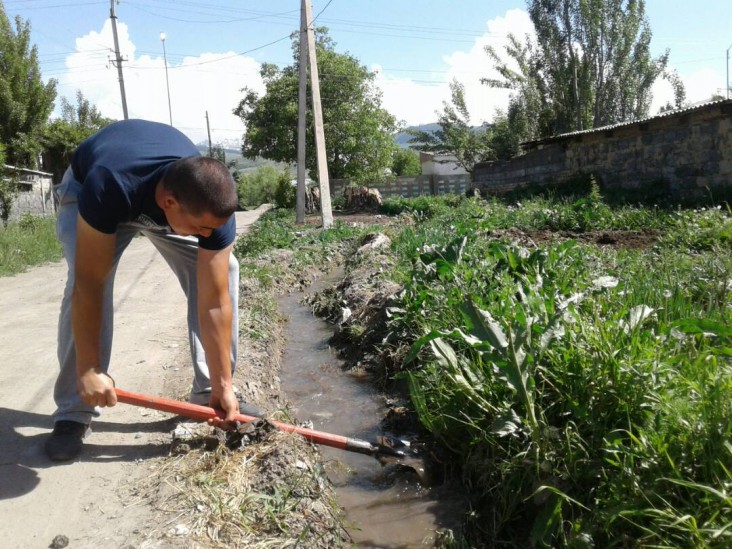
July 2017—The long-awaited dream of Kuban Akmatov has come true—this spring his apple and pear trees bloomed for the first time in a decade.
“I cannot stop admiring the beauty of my garden! Everything here was covered with weeds earlier. Due to lack of irrigation water, our attempts to grow orchards were in vain,” says Akmatov.
The irrigation channels in Karakol, one of the largest cities in eastern Kyrgyzstan, started to deteriorate a decade ago. Inefficient management, uncontrolled constructions and the absence of transitional bridges left only four functioning channels out of 10. Only 30 percent of 92,700 residents had access to irrigation water.
The situation started to change in 2015 when a local community organization, Atuul, started to mobilize the local community around the issue. Led by Galya Khurova, Atuul organized a task force consisting of local government representatives, community activists, lawyers and the media to study the problem and offer solutions. Atuul also engaged with the broader population through public discussions, where all interested citizens could suggest solutions.
All the discussions and research boiled down to a comprehensive strategy to develop the irrigation system of the city. The joint policy was adopted by the city council.
Atuul received grant support from USAID’s Collaborative Governance Program to organize the meetings with residents, identify all the problems and hire an engineer to lay out a renovation plan with proper cost estimates.
“The approved strategy took into account opinions of each competent body and hundreds of citizens. Thus, Karakol has become the only city in Kyrgyzstan that has developed a strategy for the restoration of irrigation networks with broad and active public participation,” says Khurova.
The council also allocated 3 million Kyrgyz soms (about $43,000) to restore the main city channel, replace locks and stream trays, and restore or lay new irrigation networks. As a result, more than 1,500 households gained access to irrigation water. Earlier this year, the city purchased an additional 1,200 trays for a channel that will supply gardens in two squares downtown.
Inspired by the inclusive process of developing the strategy, residents were engaged in the renovation as well. They helped to clean existing irrigation networks and build new ones. “Residents of our district, for example, in a short time renovated their domestic irrigation ditches and built networks where it was necessary,” says Ryskul Zhumakadirov, head of one of the city districts.
“Given the urgency of the issue, local authorities and the local community continue to work to restore urban irrigation to this day. We are going to accomplish this work and provide every citizen with irrigation water,” says Khurova.
What started as a simple discussion ended up as a big collaborative project that gave thousands of people access to water. The strategy is in place and the city council continues to allocate funding, which means there will be more gardens in Karakol and more happy gardeners like Kuban Akmatov.
The Collaborative Governance Program, which runs from 2013 to 2018, is designed to foster collaboration between civil society, private business and the Kyrgyz Government to improve the delivery of services, address the needs of citizens, and strengthen government accountability.
LINKS







Comment
Make a general inquiry or suggest an improvement.